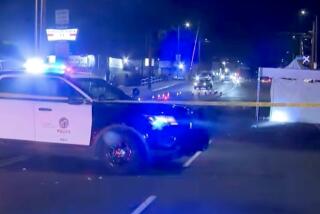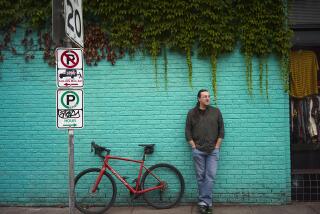Huffy vs. Hummer
Today, local blogger Will Campbell and Cato Institute senior fellow Randal O’Toole determine who bears responsibility for the road rage between cyclists and motorists. Later in the week, they’ll debate public funding for bike lanes and paths, cycling activism and more.
More cars, more blame
By Will Campbell
Oh, this one’s a no-brainer: the drivers. Numbers alone dictate they’re to blame. On one of my 13-mile morning commutes to work from Silver Lake to Westchester last week, I encountered hundreds of cars and 14 cyclists. The odds definitely favor the former to be at fault. Certainly poor roadway habits and bad manners are not the sole domain of motorists, but from my obviously biased perspective as a beleaguered bicyclist who’s been pelted with pens, cigarettes, coins, beer cans, water bottles, eggs, trash, countless expletives and advice (“Get a car!” is my personal favorite), the city’s already daunting streets can be downright inhospitable. There’s a reason a canister of pepper spray is mounted to my bike’s frame: to defend myself against the rare mad dog and the far more prevalent aggressive, ever-entitled driver. So far, I’ve never had to use it on either canine or car operator, but on occasions with the latter, I’ve come close. Let me give you an example from last August. I was on the home stretch of a casual all-day group ride that started in Highland Park and went all the way to Olympic Boulevard and the 405 Freeway in West Los Angeles before coming back to Echo Park. Returning east across town on Pico Boulevard, I wound up out ahead of the pack by a good mile or two. It had been a picture-perfect ride up until a few blocks west of Hoover Street when, while I was riding in the door zone alongside cars parked at the curb, a young man pulled his sedan tight against my left, where he called me an “ass” and flipped me the finger before speeding off only to have his clean getaway dirtied by a red light at the next intersection.
Rolling up beside him, I inquired what that unprovoked outburst was all about, and in a magnificent display of ignorance, he berated me for riding my bike in the street. His argument was that wherever there isn’t a striped bike lane, bikes aren’t allowed on the road and must stay on the sidewalk. In my magnificent incredulity, I dropped a few expletives of my own while telling him that of all the idiots I’d encountered in my 20 years of biking L.A.’s mostly bike lane-less streets, he had to be the biggest one ever. Disliking that characterization, he yanked his car out of traffic, ready to escalate matters, at which point I advised him of the pepper spray and my willingness to use it along with my bike pump and my cable lock and whatever other means necessary to subdue him and then to have him arrested for everything I could possibly get him charged with. Somewhat amazingly and thankfully common sense prevailed over his belligerent stupidity, and he opted to stay in his vehicle, where I encouraged him to think twice before harassing the next cyclist he encountered and to familiarize himself with California Vehicle Code Section 21202. We parted with him telling me to, yep, “Get a car!”
Point of order, jerk: I have one. But last year, I put fewer miles on its odometer than on my bike’s. By choice. Some might see that as a lousy choice because dealing with those motorists whose behavior ranges from inattentive to outright intimidating is a fact of life for urban cyclists on the streets of Southern California. But that’s where the numbers come back into play. Because for every bad Acura there are, of course, bunches and bunches of drivers who demonstrate a respectful and considerate willingness to share the road.
Silver Lake resident Will Campbell beat his 2007 goal to bike 2,007 miles around L.A. by nearly 1,100 miles. He blogs at Wildbell.com and Blogging.la and is an editor with Ascend Media.
Cyclists can break the law too
By Randal O’Toole
Will, you can’t blame everything on auto drivers. The truth is, there is plenty of blame to go around.
First of all, sheer numbers are not a reason to blame automobiles. We have to take a more systematic look at the problem.
I have never had the privilege of cycling in Los Angeles. But I have cycled thousands of miles each in Portland, Ore.; Denver and the San Francisco Bay Area. Drivers (and cyclists) are about the same everywhere. There are a few rude ones, a few careless ones and lots of polite ones who observe the rules of the road.
Many drivers are annoyed that too many cyclists act as though the rules of the road don’t apply to them. They run red lights, ride through stop signs without even slowing down and ride on the wrong side of the road. While I am sure that you aren’t guilty of these things, some drivers end up blaming all cyclists for the faults of a few. Don’t make the same mistake yourself.
One of the most detailed studies of bike-auto accidents was a California report that found that 46% of accidents for which blame could be ascribed were the fault of the cyclist, while 54% were the fault of the motorist. This shows that motorists, while not completely innocent, are not the only ones to blame.
While drivers have to take a test to get a license to drive, cyclists do not. So, many cyclists have no opportunity to learn how the rules of the road apply to them. I am always appalled when I see cyclists riding on the wrong side of two-way streets. Statistics show this is many times more dangerous than riding on the right, but I suspect some parents still teach their children to ride on the left.
But it would be simplistic to blame just the road users. Some of the blame must fall on road and street designers. I have always believed that cyclists and autos can share the same streets, but highway and street designers need to make some minimal efforts to account for cyclists.
More than half of all auto-bike collisions take place at intersections, yet city planners have made almost no effort to figure out how to design intersections that are safe for cyclists. Instead, they frequently install traffic lights that change only when they detect the presence of an automobile. Try as I might, I and my carbon-fiber bike sometimes simply cannot trip whatever magnetic, heat or electrical sensors are in the road. In such situations, even I have been known to run red lights.
So let’s admit that the problem is one we all share and try to find a solution that is fair to everyone. That solution should include better street and road designs, better-educated cyclists and more motorists who are willing to share the road with those cyclists.
Randal O’Toole is a senior fellow with the Cato Institute and author of “The Vanishing Automobile and Other Urban Myths: How Smart Growth will Harm American Cities.” An active cyclist who has never commuted to work by car, O’Toole is a resident of Bandon, Ore.
Day 1 | | | |


